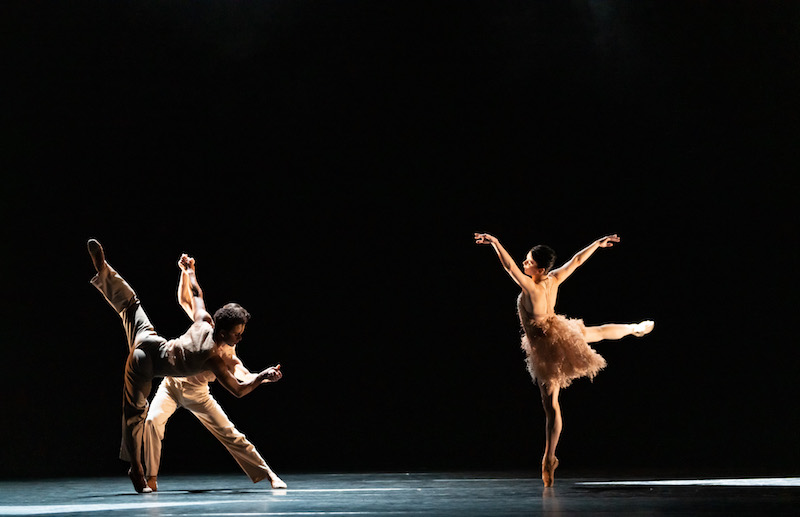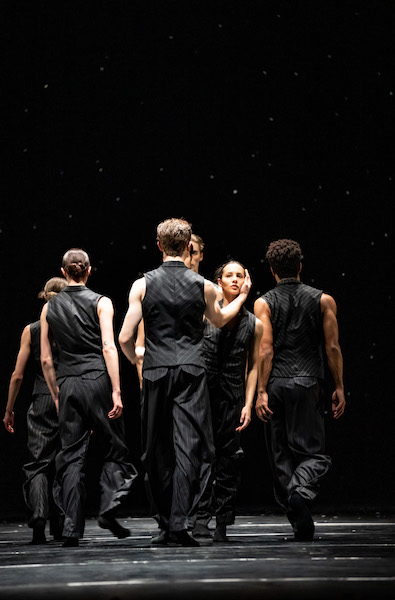The Royal Opera House wasn't taking any chances when it welcomed its first ballet audience since December this week. There was no printed programme on offer, nor even a cast sheet. “Not till October” said the uniformed man on the door. Some ballet companies have learnt the hard way not to trust that newly lifted lockdowns (lockups?) will stay that way for long. They’re in no hurry to spend time and money on printed material that might end up having to be pulped.
The programming felt confident though. The soft option for the Royal Ballet’s comeback would have been a comforting classic, but instead there’s a sense of starting afresh with work by three current, young-ish choreographers, one of them new to this company. Pittsburgh-born Kyle Abraham is already making waves in America bringing a streetdance buzz to ballet. The Royal has commissioned him to make a substantial work next season, so at just 10 minutes this new piece is something of a taster. Optional Family: A Divertissement is a trio whose tone of wry dysfunctionality is set by a synthesised voiceover. These are the unspoken thoughts of a longterm couple in crisis. “You bore me,” “Oh how I long for the longest distance from you.” “All you’ve given me is three ungrateful children”… But this is no kitchen-sink drama. The curtain rises on Natalia Osipova, crop-haired and muscular in a peach, ostrich-feathered minidress, bouréeing in wide, fussing loops around Marcelino Sambé, whose angry athleticism on the empty black stage seems wound taut by the grumbling electronic score. Which of them (pictured above) has the upper hand? You’re just starting to think you've read the situation when a third element, dancer Stanisław Węgrzyn, powers into the mix. Are the two men rivals, or are they conspiring together against Osipova? Both, possibly, and yet Osipova hardly looks a victim. The riddle is left unsolved.
Optional Family: A Divertissement is a trio whose tone of wry dysfunctionality is set by a synthesised voiceover. These are the unspoken thoughts of a longterm couple in crisis. “You bore me,” “Oh how I long for the longest distance from you.” “All you’ve given me is three ungrateful children”… But this is no kitchen-sink drama. The curtain rises on Natalia Osipova, crop-haired and muscular in a peach, ostrich-feathered minidress, bouréeing in wide, fussing loops around Marcelino Sambé, whose angry athleticism on the empty black stage seems wound taut by the grumbling electronic score. Which of them (pictured above) has the upper hand? You’re just starting to think you've read the situation when a third element, dancer Stanisław Węgrzyn, powers into the mix. Are the two men rivals, or are they conspiring together against Osipova? Both, possibly, and yet Osipova hardly looks a victim. The riddle is left unsolved.
Text plays a more integral part in The Statement (pictured top), a work made by Crystal Pite for Nederlands Dance Theatre but hungrily taken up by the Royal Ballet on the strength of their work with her on the migration ballet Flight Pattern, the hit of 2017. The Statement was originally a four-handed one-act play by Jonathon Young, and its recorded dialogue remains in Pite’s dance translation. The action happens around a large black table – perhaps in a company boardroom. Around it and sometimes on it, two men and two women, dressed for business, discuss the terms of an official statement whose exact nature we never learn. There is “a situation that needs to be cleared up”, and the protagonists seem to believe they are being scapegoated. “We should tell the truth,” one insists.”That’s impossible,” says another. “We have to stay on script”. The lack of any pinpointable meaning in these urgent negotiations, the verbal swerves and obfuscations, is both sinister and very funny. As, too, is the negotiators’ body language, a cartoonish exaggeration of normal office behaviours, delivered at whip-smart speed. Hands splay wide on the table, heads butt combatively. When doubts are voiced, legs get the jitters. It’s a brilliant conceit, and these dancers rise magnificently to the challenge.
 Solo Echo (pictured right) uses more dancers, and at first seems more conventional in setting extracts from two Brahms cello sonatas. But here too Pite plays on the ability of dance to deliver meaning incrementally. As snow drifts down prettily in the background, the dancers are buffeted by the music’s high romance through a series of rumbustious solos and duets. Later the mood becomes fraught as motifs of support and falling accumulate. If Pite has a choreographic signature, it’s her use of queues or piles of bodies. She’s great at manipulating numbers into poetic ideas. Here, when dancers peel away from group it’s like a series of absences among old friends. It’s only in the final moments that you clock Pite’s theme: a completed cycle of life and love.
Solo Echo (pictured right) uses more dancers, and at first seems more conventional in setting extracts from two Brahms cello sonatas. But here too Pite plays on the ability of dance to deliver meaning incrementally. As snow drifts down prettily in the background, the dancers are buffeted by the music’s high romance through a series of rumbustious solos and duets. Later the mood becomes fraught as motifs of support and falling accumulate. If Pite has a choreographic signature, it’s her use of queues or piles of bodies. She’s great at manipulating numbers into poetic ideas. Here, when dancers peel away from group it’s like a series of absences among old friends. It’s only in the final moments that you clock Pite’s theme: a completed cycle of life and love.
Christopher Wheeldon’s The Golden Hour, at the top of the bill, uses large forces and provides the relief from all that black. Vivaldi’s “Summer” meets Cajun folk in Ezio Bosso’s gorgeous music for strings, while Jasper Conran’s costumes shimmer and wink under gilded light. This piece has earned its keep for the Royal Ballet over the past year, not least as the headline item in its winter streaming while Britain was at its gloomiest. Happily, it’s a piece that bears much repeating.














Add comment